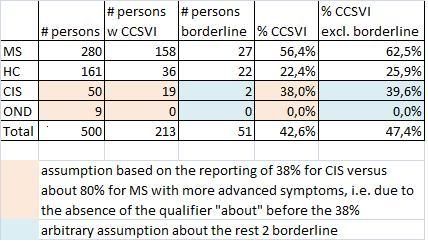My breakdown of the percentages reported...
Posted: Thu Feb 18, 2010 3:47 pm
OK, perhaps I’m off base but this is how I read the data as it was presented in the press release:
500 subjects in three groups:
280 CDMS
161 Health Controls
59 OND/CIS
The wording of the press release talked about those with MS and Healthy Controls, so I don’t think that the 59 OND/CIS patients are included in the reported percentages (could be wrong).
The below math is based on the assumption that the OND/CIS patients are NOT included in the percentages reported in the press release
The percentages reported:
56.4% with MS showed 2 or more indicators CCSVI (apx 158 with CCSVI, 122 without CCSVI)
22.4% of healthy controls showed 2 or more indicators of CCSVI (apx 36 with CCSVI, 125 without CCSVI)
10.2% of subjects were borderline, some from both the CDMS and HC groups. (about 45 people)
The article states that if the 10.2% were added to the CCSVI category it would increase the CDMS % to 62.5%, or in flat number the positives would rise from 158 to about 175 in that group. That tells me that of the estimated 45 patients who fell within the borderline category, 17 were from the MS group and 28 were from the Health Controls group.
I don’t know if my math is wrong, but if its fairly accurate then I think what we’re going to learn something like:
1) CCSVI is a whole different disorder from MS that could be more common in MS patients.
2) CCSVI is the trigger of MS, but the testing/diagnostics to date are not what it needs to be in order to properly diagnose.
3) MS will be found out to be an umbrella disease that has been used as a catch-all to put those with ‘ms’ like symptoms into the same bucket because they didn’t know where else to put them, and that a number of MS patients may really just have vein disorders, while others truly have ‘MS’ and CCSVI isn’t present.
4) This list could go on for a while…..
I believe CCSVI truly is the cause of a lot of MSers pain/progression/symptoms, but I’m starting to wonder if this discovery isn’t just going to fraction the MS community into those with MS (or something else) and those with CCSVI.
These next couple of months are going to be very interesting…..
500 subjects in three groups:
280 CDMS
161 Health Controls
59 OND/CIS
The wording of the press release talked about those with MS and Healthy Controls, so I don’t think that the 59 OND/CIS patients are included in the reported percentages (could be wrong).
The below math is based on the assumption that the OND/CIS patients are NOT included in the percentages reported in the press release
The percentages reported:
56.4% with MS showed 2 or more indicators CCSVI (apx 158 with CCSVI, 122 without CCSVI)
22.4% of healthy controls showed 2 or more indicators of CCSVI (apx 36 with CCSVI, 125 without CCSVI)
10.2% of subjects were borderline, some from both the CDMS and HC groups. (about 45 people)
The article states that if the 10.2% were added to the CCSVI category it would increase the CDMS % to 62.5%, or in flat number the positives would rise from 158 to about 175 in that group. That tells me that of the estimated 45 patients who fell within the borderline category, 17 were from the MS group and 28 were from the Health Controls group.
I don’t know if my math is wrong, but if its fairly accurate then I think what we’re going to learn something like:
1) CCSVI is a whole different disorder from MS that could be more common in MS patients.
2) CCSVI is the trigger of MS, but the testing/diagnostics to date are not what it needs to be in order to properly diagnose.
3) MS will be found out to be an umbrella disease that has been used as a catch-all to put those with ‘ms’ like symptoms into the same bucket because they didn’t know where else to put them, and that a number of MS patients may really just have vein disorders, while others truly have ‘MS’ and CCSVI isn’t present.
4) This list could go on for a while…..
I believe CCSVI truly is the cause of a lot of MSers pain/progression/symptoms, but I’m starting to wonder if this discovery isn’t just going to fraction the MS community into those with MS (or something else) and those with CCSVI.
These next couple of months are going to be very interesting…..
